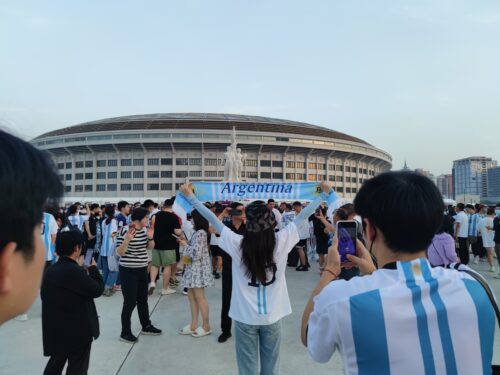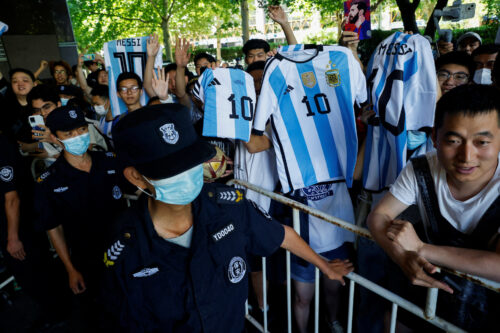World Cup drawing nearly 100 million primetime viewers in China

The China Sports Column is a The China Project weekly feature in which China Sports Insider Mark Dreyer looks at the week that was in the China sports world.
China’s national soccer team remains a disappointment, but the long-suffering fans have more than delivered during this World Cup so far, despite a viewing schedule that’s about to get a little worse.
Argentina’s 1-1 tie with Iceland last Saturday set the benchmark early on for the most TV viewers in China, with an average of 45 million viewers per minute throughout the match and 91 million fans tuning in for at least some of the game, according to CSM Media Research. Earlier this week, that mark was beaten when more than 95 million watched at least part of South Korea’s 1-0 defeat to Sweden, narrowly ahead of the 94 million who saw Japan beat Colombia 2-1 the following day. But all of that was topped by the 8 pm Portugal vs. Morocco game on Wednesday, which drew just a shade under 100 million.
Related reading:
Japan’s World Cup win was “Asia’s victory,” says Chinese newspaper
While these games might not seem like the most glamorous ones on the schedule — especially with Chinese fans known to be hostile towards their Asian rivals — timing in China is everything, and that means the 8 pm prime time slot reigns supreme.
The other “early” kick-offs — Costa Rica vs Senegal and Uruguay vs Egypt — have also drawn far more viewers than later, more attractive fixtures, with the 11 pm games drawing only about a third of the number of viewers and the 2 am kickoffs headlined by the hardy 10 million who stayed up to watch the 3-3 thriller between Portugal and Spain.
Accurate numbers are nearly impossible to come by in China, but these figures come from about as reputable — and independent — a source as you can get in this country, and would be even larger when online viewers are taken into account (though it’s worth pointing out that far fewer viewers in China will be streaming World Cup games on their cell phones than basketball fans watching the NBA on the way to work or at the office during the morning).
The numbers also serve to validate the decision by Chinese firms to spend so much on sponsoring the World Cup, with more than a third of all official FIFA World Cup sponsors hailing from China.
In short, China simply delivers massive audiences.
By comparison, an average of 13.7 million people watched England’s 2-1 nail-biting win over Tunisia in the soccer-mad country (peaking at 18.3 million toward the end), and that was for a match that kicked off at the ideal time of 7 pm in London. Incidentally, only 11.2 million UK viewers watched Harry and Meghan tie the knot recently.
Over in the U.S., which will stage the lion’s share of the 2026 World Cup matches, an average of 11 million fans watched Mexico — arguably the best supported team in the country — run out 1-0 winners over Germany, with Spanish-language coverage outnumbering English-language viewers by a ratio of 3 to 2.
But the good news for sponsors in China — and for fans — is about to come to an end. Sunday’s 8 pm game between England and Panama marks the last of the tournament’s earlier kick-offs, with the final round of group games and all knockout games held at either 10 pm or 2 am, with the exception of the final (11 pm China time).
If the popular teams like Brazil, Germany, Argentina, and Portugal go far in the tournament, Chinese fans will undoubtedly still be staying up in their millions, but don’t expect any viewing records to be broken until the tournament moves to Qatar (five hours behind China) in 2022, or, better yet, even further east at some point in the future.

Cameron Wilson from the Wild East Football website has been tweeting pictures (e.g., above) from his Shanghai apartment that show local residents staying up to watch World Cup games. That may just be anecdotal evidence, but the trend is well and truly backed up by China’s food delivery giants.
A report from the Beijing Daily quoted figures from Meituan Dianping, which said it saw a 40 percent jump in deliveries 15 minutes before the World Cup’s first game last week, with a 55 percent rise in stew and soup orders.
Between 9 pm and midnight later that night, it claimed 280,000 bottles of beer and 1.53 million crayfish were delivered to its customers.
Meanwhile, rival Ele.me said it delivered an average of 3.05 million crayfish and 400,000 bottles of beer for each of the first four World Cup games.
And while Ele.me has certainly seen plenty of year-on-year growth, especially since being acquired by Alibaba in April, the company said it received three times as many orders between 9 pm and 2 am on the first two nights of the tournaments as it had done a year previously.
No word, though, on whether Starbucks is seeing more morning traffic as fans struggle to stay awake on the days after the nights before.
Related reading:
Hole in the wall 2.0: How China’s food delivery industry is changing the restaurant business
Some other football stories worth your time this week:
- Wu Haiyun from Sixth Tone blows up the stereotype of Chinese female soccer fans who only watch for the tight shorts and shirts-off celebrations, while this fascinating piece from China Daily profiles the all-but-forgotten former England international Frank Soo, who was once referred to by legendary striker Dixie Dean as one of England’s greatest talents and was named in former England manager Joe Mercer’s all-time XI.
- Gambling on World Cup games is big in China, but losers sometimes just don’t take losses very well. Here’s a compilation of gamblers attacking television screens:
The China Sports Column runs every Friday on The China Project. Follow Mark Dreyer @DreyerChina






